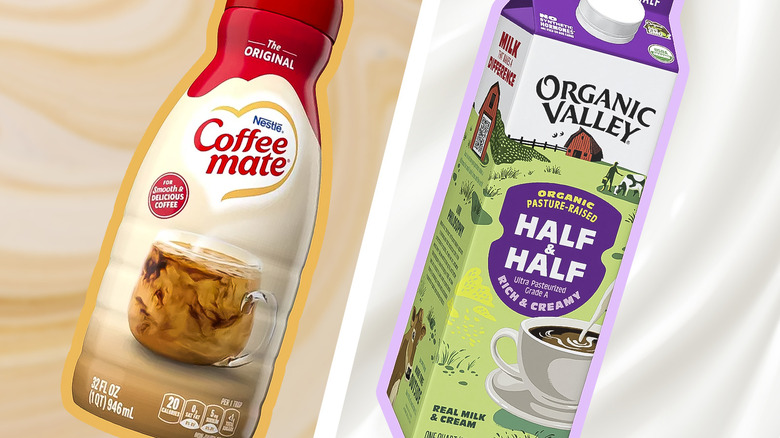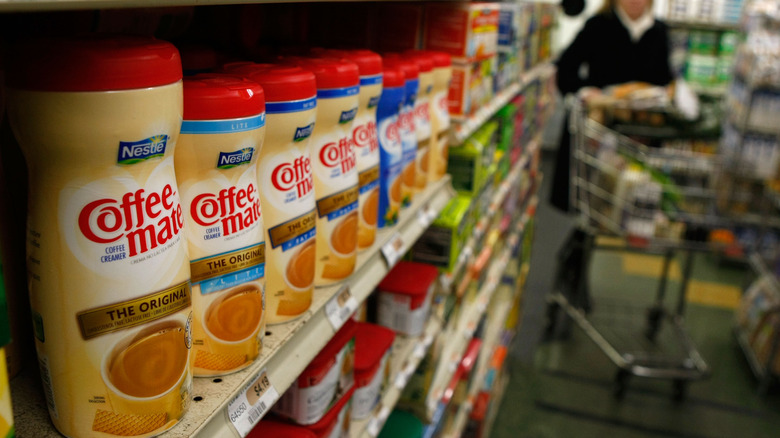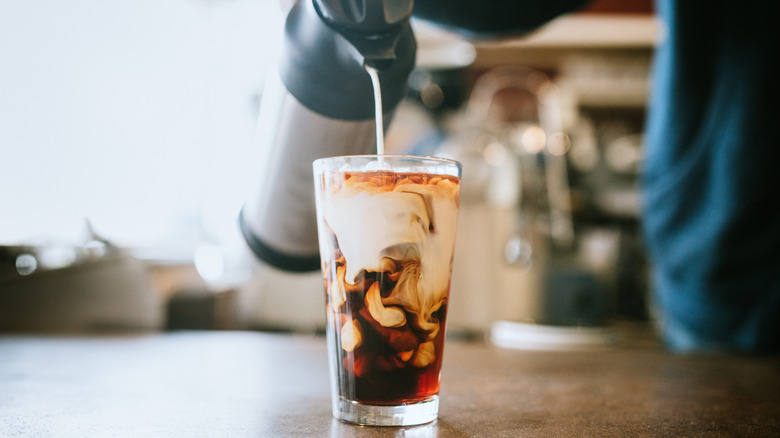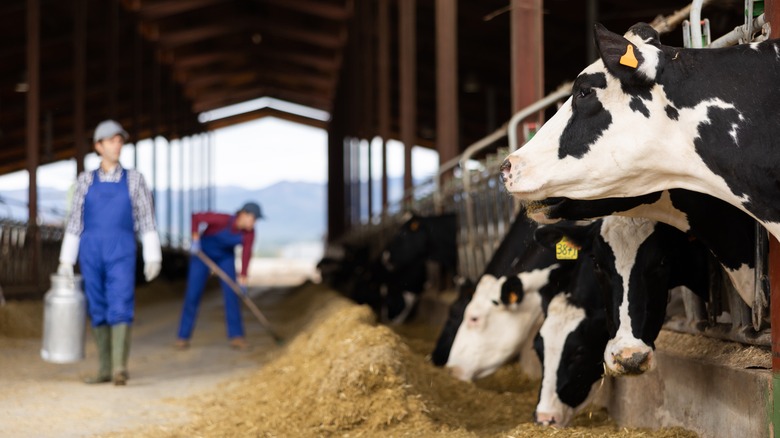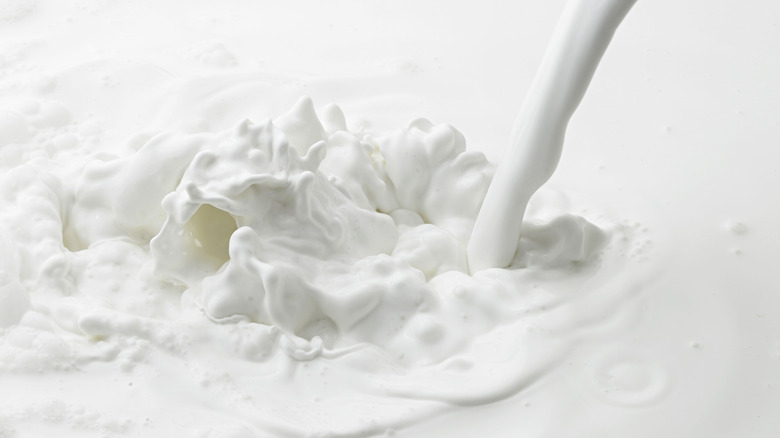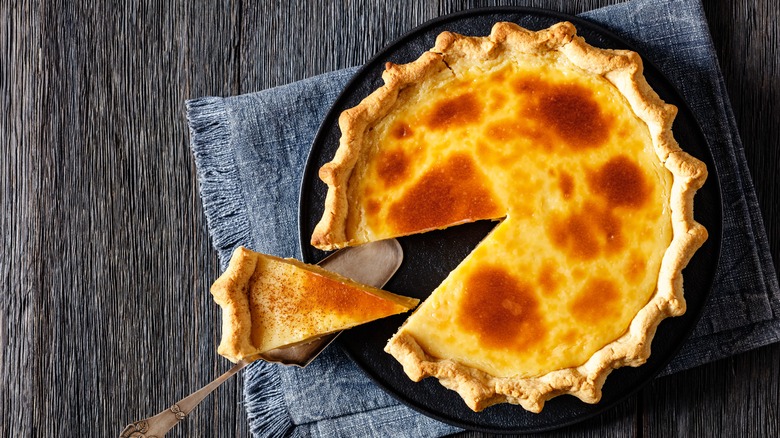Creamer Vs Half-And-Half: What's The Difference?
You can tell this country loves its coffee because, when you browse the supermarket aisles, it's not pasta sauces or breakfast cereals that are overwhelming you with new options, it's the exploding selection of coffee creamers alongside the milk and half-and-half, and it's up to you to sort out the difference. There was a time not that long ago when your morning cup of coffee was a simple operation. Pre-ground beans from just a few companies, percolator, and some half-and-half — all done. The rise of gourmet coffee brought with it whole aisles of popular coffee brands and a half-dozen new ways of brewing your cup, and that already felt like enough choices to make. Then, competition got tough, and the big chains moved on to flavors.
Hazelnut and vanilla were not enough; we needed mocha and caramel, peppermint, toffee, and, of course, pumpkin spice lattes. Our coffee creamers have followed suit, and now you can spend half-an-aisle browsing all of the choices. Creamers have been around for a while as an alternative to milk and half-and-half, but it wasn't always as triumphant as it is today. Coffee purists have always touted black as the way to go, but creamer had even more of a stigma compared to half-and-half. It was a cheap, fake way to dress up your coffee. But do people even know what creamer is? Why was it so suspect? And what is so different between creamer and half-and-half that people would make the judgment to begin with?
What is creamer?
Creamer can refer to a wide variety of products but is most commonly a non-dairy alternative to milk and cream, usually added to coffee or tea. Creamers come in both liquid and powdered forms, with versions that can be low-sugar, low-fat, and plenty of different flavors, with French Vanilla and Hazelnut being common options. Instead of dairy, basic creamers are usually based around a mix of sweeteners, fats like vegetable oil, thickeners, and water. However, alternative milk creamers have gotten more popular in recent years, with almond and oat milk creamers that are dairy-free available at most grocery stores. Being dairy-free, it's considered a good substitute for people who are lactose intolerant or vegan.
Non-dairy coffee creamers actually date back all the way to the 1940s, when the first soy-based coffee mix-in was developed. Powdered creamer first became popular in the 1950s with products like Pream, and this time also saw the first use of the term "coffee creamer." The two biggest names on the market are Coffee-Mate, which has been around since 1961 and is the top-selling creamer, and International Delight, which arrived in 1987 and is the number two seller. Recently, other big name brands like Silk and Oatly have also started selling creamers. Confusingly, the term has become so popular and associated with coffee that even Starbucks and Chobani creamers use the term, even though they are usually made with milk.
What is half-and-half?
Half-and-half is a dairy product, and it can be found with all of the different types of cream and milk at the grocery store. In fact, the name is a simple description to indicate that half-and-half is a mix of half whole milk and half cream. In fact, it is so simple that you can make it at home by whisking together equal parts heavy cream and milk.
The U.S. Food and Drug Administration regulates half-and-half labeling and defines it as containing between 10.5% and 18% milk fat, which is also about half of heavy cream's standard 36%. The average fat for half-and-half falls on the low end of this definition, usually around 10%-12%. You may also see non-fat half-and-half, which is a somewhat confusing product that is not actually half-and-half since it has no cream. Instead, it is a mix of milk, corn syrup, and thickeners — not all that different from a dairy-based creamer.
Despite dairy's long history of being used in Western cuisine and cooking, half-and-half is a relatively new product that's not much older than creamer. The mix was invented at Boutwell Dairy in Lake Worth, Florida in the 1920s. Because of its middle ground fat content, it fulfills niche roles compared to other dairy products, with coffee being its biggest use. It does not have the fat to be whipped like cream, and it's not consumed straight up like milk, but it can add a light richness to plenty of recipes.
Creamer is usually not dairy-based
The biggest difference between creamer and half-and-half is the lack of dairy in most creamers. Vegetable oil or corn syrup are how they get the richness to mimic cream, but many creamers are ultra-processed products and contain lots of other additives. They contain gums, emulsifiers, thickeners, and preservatives, and the flavors are usually artificial as well. Even plant-based creamers based on things like almond milk may use these additives to achieve a cream-like texture, and some contain added oils too. Although not ideal for many people, this does give creamer the advantage of lasting longer in the fridge.
It's also worth checking the ingredients in your creamer because if you are lactose intolerant or vegan, creamers won't always be dairy-free. Some brands, like Chobani, simply use the term coffee creamer for flavored dairy-based mixers despite the name's historic association with dairy-free products. And some varieties of creamer even use an ingredient called casein, which is a type of milk protein. While safe for people with lactose intolerance, using a milk protein might be enough to disqualify those creamers from being considered vegan.
Half-and-half is always going to be dairy-based — even the fat-free half-and-half with no cream. It's completely natural and should not even have an ingredient list. However, this does mean that its liable to spoil in about a week after being opened.
Both creamer and half-and-half don't offer much nutrition
Despite the dueling natures of the more natural half-and-half and the more artificial nature of most creamers, the nutritional profile is not significantly different — neither offers much in the way of vitamins or minerals. Because half-and-half is made from milk, it does usually have some nutrients, like calcium and potassium, but the small serving sizes of a few tablespoons means that the amounts you're consuming will be negligible.
With creamer, the artificial ingredients don't offer anything at all, and even non-dairy creamers made from alternatives like almond milk don't often provide any vitamins or nutrients either. The one thing creamer does have is sugar, and plenty of it. A tablespoon sized serving of creamer will have up to 5 grams of added sugar in it. That's over 10% of your daily recommended intake in one small spoonful. Half-and-half has the advantage of being sugar free, unless you add it yourself.
However half-and-half does have more fat than most creamers. One serving of half-and-half will have about 10% of your daily recommended limit of saturated fat, and also some cholesterol. Creamer on the other hand will usually be cholesterol and saturated fat free, with a negligible amount of total fat.
Half-and-half has a more neutral flavor
Half-and-half has the smooth taste of milk but, because of the added cream, it will have a stronger flavor than whole milk. It has no added sweeteners or sugar and is not sweet at all. However, the fat adds a welcome richness to anything half-and-half is used in, including coffee, of course. While it will add a creaminess and dairy smoothness that lightens flavor, it's not an intense taste and is a good neutral option for people who want to maintain the flavor of their coffee.
Creamer usually has a stronger flavor than half-and-half. Even unflavored versions of creamer are usually high in sugar, and, thus, have a more intense sweet cream taste to them. If you want a lighter taste, you'll need to find creamers that specify unsweetened, as even sugar-free creamers usually have artificial sweeteners in them. Beyond that, there are a ton of options for creamers depending on your personal preferences. There are lots of coffee creamer brands, and oat milk, almond milk, or traditional non-dairy creamers will all have unique taste profiles. Within those brands, you'll find dozens of flavors, too, ranging from popular coffee options like mocha to special releases for holidays like pumpkin spice and caramel apple, and even brand collaborations like Coffee-Mate's recent seasonal KitKat creamer.
Both creamer and half-and-half have uses outside of coffee
While coffee is the clear number one use for both creamer and half-and-half, they both can serve purposes beyond that. Half-and-half can be especially useful in the kitchen because of its unique mix of milk and cream. It can make a great, lighter substitution for creamy sauces and soups that normally use heavy cream, and a great addition for rich grits or polenta. While it won't whip, half-and-half is also useful for baking, where you can use it to make pies, quiches, or tender cakes and pastries that need a little more fat than whole milk can bring. In fact, most recipes that use milk can incorporate half-and-half if you want the extra fat, from scrambled eggs to mashed potatoes.
Because of its sweetness and lack of fat, you'll need to get more creative to use creamer outside of coffee, but it can work. If you don't mind the sugar, liquid creamer can be a nice alternative to milk in cereal, and it can even be drizzled over pancakes or waffles for some extra creamy taste. Or try adding it to smoothies for a sweet boost. Creamer can even make frosting or glazes as a one-to-one substitution for milk. It may not be as versatile as half-and-half, but if you love the taste of your favorite creamer, there are plenty of places to sneak it in.
